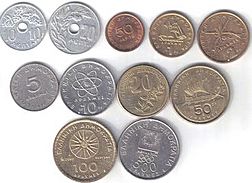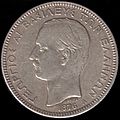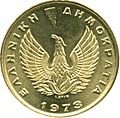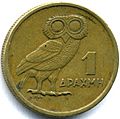Modern drachma facts for kids
Quick facts for kids Modern drachma |
|
|---|---|
| ISO 4217 Code | GRD |
| User(s) | None, previously: |
| Inflation | 3.1% (2000) |
| Source | Grecian.net |
| ERM | |
| Since | March 1998 |
| Fixed rate since | 19 June 2000 |
| Replaced by €, non cash | 1 January 2001 |
| Replaced by €, cash | 1 January 2002 |
| € = | ₯340.75 |
| Subunit | |
| 1⁄100 | leptοn (λ) |
| Symbol | ₯ |
| Coins | |
| Freq. used | ₯5, ₯10, ₯20, ₯50, ₯100, ₯500 |
| Rarely used | 10λ, 20λ, 50λ, ₯1 and ₯2 |
| Banknotes | |
| Freq. used | ₯200, ₯1,000, ₯5,000, ₯10,000 |
| Rarely used | ₯50, ₯100, ₯500 |
| Printer | Banknote and Securities Printing Foundation |
The drachma (Greek: δραχμή) was the main money used in modern Greece. It was used from 1832 until the euro was introduced in 2001. The drachma has a long history, going back to ancient times.
Contents
The First Modern Drachma (1832-1944)
The drachma was brought back in May 1832. This was just before the Kingdom of Greece was officially formed. It took the place of an older currency called the phoenix. One drachma was divided into 100 smaller units called lepta.
Early Drachma Coins
The first drachma coins were made of different metals.
- Copper coins came in values of 1, 2, 5, and 10 lepta.
- Silver coins were for 1⁄4, 1⁄2, 1, and 5 drachmas.
- There was also a gold 20-drachma coin.
A 1-drachma coin weighed 4.5 grams and was made of 90% silver.
In 1868, Greece joined a group of countries called the Latin Monetary Union. This meant the drachma became equal in value to the French franc. New coins were made, including copper, silver, and gold coins. Some 5 and 10 lepta coins were even given special names: obolos and diobolon.
Later, in 1894, new coins made of cupro-nickel were introduced. These were for 5, 10, and 20 lepta. After 1911, no more 1 or 2 drachma silver coins were made. There were no new coins at all between 1912 and 1922. This was because of World War I, which caused the Latin Monetary Union to break apart.
Between 1926 and 1930, Greece introduced new coins for its new government. These included coins made of cupro-nickel, nickel, and silver. These were the last coins for the first modern drachma.
The Second Modern Drachma (1944-1954)
After Greece was freed from Nazi Germany on November 11, 1944, the old drachma was replaced. People exchanged 50 billion old drachmas for just 1 new drachma! Only paper money was printed for this second drachma.
The government printed notes for 1, 5, 10, and 20 drachmas. The Bank of Greece printed larger notes, like 50, 100, 500, 1,000, 5,000, and 10,000 drachmas. This period also saw a lot of inflation, which means money quickly lost its value. Because of this, even larger notes like 20,000 and 50,000 drachmas were printed later.
The Third Modern Drachma (1954-2002)
On April 9, 1953, Greece joined the Bretton Woods system to help control inflation. Then, on May 1, 1954, the drachma was revalued again. This time, 1,000 old drachmas became 1 new drachma. Small change notes were stopped.
The third drachma had a fixed value against the United States dollar. For many years, 30 drachmas were equal to one dollar. However, over time, the drachma slowly lost value against the dollar. By 1973, it took 400 drachmas to equal one dollar.
Finally, on January 1, 2002, the Greek drachma was officially replaced by the euro. The drachma stopped being legal money on March 1, 2002.
Third Modern Drachma Coins
The first coins for the third drachma were made in 1954. They included:
- Holed aluminum coins for 5, 10, and 20 lepta.
- Cupro-nickel coins for 50 lepta, 1, 2, and 5 drachmas.
- 10-drachma coins were added in 1959.
- A silver 20-drachma coin was made in 1960.
Many coins from 50 lepta to 20 drachmas showed a picture of King Paul. New coins were made in 1966 with King Constantine II on them. In 1963, a special 30-drachma silver coin was made to celebrate 100 years of Greece's royal family.
In 1971, the design on the back of all coins changed. This was to show the military government that was in power. The design included a soldier and a phoenix rising from flames.
In 1973, a new 20-drachma coin with Europa was made. Later that year, more new coins were introduced. These coins showed a phoenix rising from flames and said "Hellenic Republic" (the new name for Greece). In 1976, a new set of coins was released, showing pictures of early Greek heroes.
Larger coins were introduced later:
- Cupro-nickel 50-drachma coins in 1980.
- Aluminum-bronze 50-drachma coins in 1986.
- Copper 1 and 2-drachma coins in 1988.
- Aluminum-bronze 20 and 100-drachma coins in 1990.
In 2000, special 500-drachma coins were made to celebrate the 2004 Summer Olympics in Athens.
Here are the coins that were still used when the euro took over:
- 50 lepta (worth about €0.0015)
- ₯1 (worth about €0.0029)
- ₯2 (worth about €0.0059)
- ₯5 (worth about €0.0147)
- ₯10 (worth about €0.0293)
- ₯20 (worth about €0.0587)
- ₯50 (worth about €0.147)
- ₯100 (worth about €0.293)
- ₯500 (worth about €1.47)
Third Modern Drachma Banknotes
The first banknotes for the third drachma were for 10, 20, and 50 drachmas. Soon after, 100, 500, and 1,000 drachma notes were added by 1956. Larger notes for 5,000 drachmas came out in 1984. Then, 10,000 drachma notes were introduced in 1995, and 200 drachma notes in 1997.
Here are the banknotes that were still used when the euro took over:
- ₯100 (worth about €0.2935), showing Athena and Adamantios Korais.
- ₯200 (worth about €0.5869), showing Rigas Feraios.
- ₯500 (worth about €1.47), showing Ioannis Capodistrias.
- ₯1,000 (worth about €2.93), showing Apollo.
- ₯5,000 (worth about €14.67), showing Theodoros Kolokotronis.
- ₯10,000 (worth about €29.35), showing George Papanicolaou and Asclepius.
Images for kids
-
Gold ₯20 coin depicting king Othon I, 1833
-
₯1 coin depicting Konstantinos Kanaris, 1976
-
₯5,000,000 banknote during the Axis Occupation hyperinflation period, 1944
See also
 In Spanish: Dracma griega moderna para niños
In Spanish: Dracma griega moderna para niños
- Commemorative coins of Greece
- Economy of Greece
- Greek euro coins
- Phoenix (currency)















